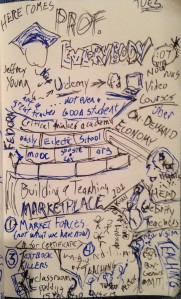 One of the SXSWedu sessions I sketchnoted was “Here Comes Prof. Everybody” and one of the phrases that caught my attention described how developments such as Coursera and Fedora promote the “unbundling of teaching.” Technology now allows teachers to reach student and learners directly, rather than “bundling” their teaching expertise into a larger class or course, quite a liberating effect for some educators.
One of the SXSWedu sessions I sketchnoted was “Here Comes Prof. Everybody” and one of the phrases that caught my attention described how developments such as Coursera and Fedora promote the “unbundling of teaching.” Technology now allows teachers to reach student and learners directly, rather than “bundling” their teaching expertise into a larger class or course, quite a liberating effect for some educators.
At the session, I commented about perhaps needing to unbundle learning as well as teaching. After some thought, though, I’ve decided learning is always unbundled from what the teacher or trainer presents because the learner’s attention drifts, so each learner only catches some of the content, and must bundle that new information together with existing knowledge — which will differ for each learner. It becomes incumbent on the individual to re-bundle the new knowledge, skill, or ability into useful learning.
Then I thought back on my own self-directed learning. Since the first time I encountered the possibility of self-paced learning — a 5th-grade reading program where you worked up through levels of complexity — I’ve found that I often do a better job of directing my own learning. That first opportunity, I quickly read my way through all the reading levels and topped out. I felt like a young stallion set free from the bridle, ready to run like the wind — a rare sensation for too many students.
Bored at home in the summer before 7th grade, I taught myself basic algebra from an article in World Book Encyclopedia — it reminded me of solving puzzles, and I loved the challenge. Again, learning a complex task on my own felt remarkably liberating.
While high school did allow for some independent learning, even that had to fit within the strictures of a classroom. I took journalism as a remedy, and got to wander the halls, ostensibly looking for “hot tips,” but more likely hanging out in the library. Eventually, I found our school library to be wholly inadequate, and took to making cross-town drives with friends to visit the Rice library, which seemed to hold every book ever known — and then some.
On a lark, I learned how to play bridge through programmed learning, using a “programmed text,” where you read a short chunk of content, then choose an answer to a practical question. Each answer option directs you to a different page in the book, where you receive feedback based on your choice. Though I never really took up the game of bridge (just not that competitive), I loved how that approach worked: chunking learning into small bites and forcing me into decisions with feedback, enticing me forward with a gentle sense of learning guidance.
By the time I went through college, independent study projects comprised close to 25% of my coursework — even more in graduate school. To this day, I retain a voracious appetite for new learning, attending professional development conferences (such as SXSWedu) and local workshops to quench my thirst for learning. Using resources such as Lynda.com or Creative Live, various MOOCs (massive open on-line courses) or even YouTube, I can choose what — and when — I want to learn.
The question as we move forward is: knowing that independent, self-directed learning can work so well for an individual, can we successfully integrate it into our educational and training systems?
Or perhaps we should re-phrase that question: How can we successfully integrate self-directed learning into our educational and training systems?


Regarding your closing question(s), I would argue that we need not spend too much time fretting over how to incorporate self-directed learning into our current educational and training systems. The current educational model used by the majority of institutions of higher learning has been systematically flawed for at least a century (with the lecture-type model of knowledge diffusion, majorly inefficient assessment methods, and lack of critical and creative thinking skills), and I believe we are finally approaching the tipping point towards radical change. What I think what is going to happen (and I admit this is only speculation, but I believe I can back most of my claims with hard evidence) is that the dozens of alternative education initiatives that have sprung up in the last decade (Minerva Schools, Coding Bootcamps, Uncollege, Thiel Fellowships, Open Source Learning etc etc) are going to force an institutional paradigm shift. Institutions are going to adapt or die. What are your thoughts on this?
By the way, I have started my own initiative towards self-directed learning, It is an experiment that I am doing on myself, taking advantage of all the online tools now available to us. If you have a minute take a look around and tell me what you think, I would love your input!
Pingback: SXSWedu: Taking Learning Experiences to the Extreme | Buller's back porch